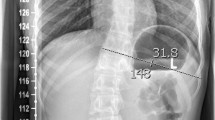Abstract
Purpose
The Cobb technique is the universally accepted method for measuring the severity of spinal deformities. Traditionally, Cobb angles have been measured using protractor and pencil on hardcopy radiographic films. The new generation of mobile ‘smartphones’ make accurate angle measurement possible using an integrated accelerometer, providing a potentially useful clinical tool for assessing Cobb angles. The purpose of this study was to compare Cobb angle measurements performed using a smartphone and traditional protractor in a series of 20 adolescent idiopathic scoliosis patients.
Methods
Seven observers measured major Cobb angles on 20 pre-operative postero-anterior radiographs of Adolescent Idiopathic Scoliosis patients with both a standard protractor and using an Apple iPhone. Five of the observers repeated the measurements at least a week after the original measurements.
Results
The mean absolute difference between pairs of smartphone/protractor measurements was 2.1°, with a small (1°) bias toward lower Cobb angles with the iPhone. 95% confidence intervals for intra-observer variability were ±3.3° for the protractor and ±3.9° for the iPhone. 95% confidence intervals for inter-observer variability were ±8.3° for the iPhone and ±7.1° for the protractor. Both of these confidence intervals were within the range of previously published Cobb measurement studies.
Conclusions
We conclude that the iPhone is an equivalent Cobb measurement tool to the manual protractor, and measurement times are about 15% less. The widespread availability of inclinometer-equipped mobile phones and the ability to store measurements in later versions of the angle measurement software may make these new technologies attractive for clinical measurement applications.







Similar content being viewed by others
Notes
Measurement of Cobb angles using the iPhone involved measuring the angle of the inferior and superior vertebral endplates selected and then adding these numbers together to obtain the Cobb angle. Since performing this study, a newer version of the software application enables the addition of the two angles automatically thus avoiding a potential error in simple addition by the observer.
References
Cobb JR (1948) Outline for the study of scoliosis. Am Acad Orthop Surg Instr Course Lect 5:261–275
Kotwicki T (2009) Evaluation of scoliosis today: examination, X-rays and beyond. Disabil Rehabil 30:742–751
Whittle MW, Evans M (1979) Instrument for measuring the Cobb angle in scoliosis. Lancet 1(8113):414
Vrtovec T, Pernus F, Likar B (2009) A review of methods for quantitative evaluation of spinal curvature. Eur Spine J 18:593–607
Bland JM, Altman DG (1986) Statistical methods for assessing agreement between two methods of clinical measurement. Lancet 1(8476):307–310
Bland JM, Altman DG (2003) Applying the right statistics: analyses of measurement studies. Ultrasound Obstet Gynecol 22:85–93
Lenke LG, Betz RR, Harms J et al (2001) Adolescent idiopathic scoliosis: a new classification to determine extent of spinal arthrodesis. J Bone Joint Surg Am 83:1169–1181
Shea KG, Stevens PM, Nelson M et al (1998) A comparison of manual versus computer-assisted radiographic measurement: intraobserver measurement variability for Cobb angles. Spine 23:551–555
Ylikoski M, Tallroth K (1990) Measurement variations in scoliotic angle, vertebral rotation, vertebral body height, and intervertebral disc space height. J Spinal Disord 3:387–391
Dutton KE, Jones TJ, Slinger BS et al (1989) Reliability of the Cobb-angle index derived by traditional and computer-assisted methods. Australas Phys Eng Sci Med 12:16–23
Morrissy RT, Goldsmith GS, Hall EC et al (1990) Measurement of the Cobb angle on radiographs of patients who have scoliosis. J Bone Joint Surg Am 72:320–327
Zmurko MG, Mooney JF, Podeszwa DA et al (2003) Inter- and intraobserver variance of Cobb angle measurements with digital radiographs. J Surg Orthop Adv 12:208–213
Adam CJ, Izatt MT, Harvey JR et al (2005) Variability in Cobb angle measurements using reformatted computerized tomography scans. Spine 30:1664–1669
Facanha-Filho FAM, Winter RB, Lonstein JE et al (2001) Measurement accuracy in congenital scoliosis. J Bone Joint Surg Am A 83(1):42–45
Loder RT, Urquhart A, Steen H et al (1995) Variability in Cobb angle measurements in children with congenital scoliosis. J Bone Joint Surg Br 77:768–770
Carman DL, Browne RH, Birch JG (1990) Measurement of scoliosis and kyphosis radiographs. J Bone Joint Surg Am 72:328–333
Oda M, Rauh S, Gregory P et al (1982) The significance of roentgenographic measurement in scoliosis. J Pediatr Orthop 2:378–382
Heckman JD, Loder RT, Hensinger RN et al (2002) Statistical differences: consider the methodology. J Bone Joint Surg Am 84:1078
Beekman CE, Hall V (1979) Variability of scoliosis measurement from spinal roentgenograms. Phys Ther 59:764–765
Acknowledgments
The authors wish to acknowledge the contribution of Dr Simon Gatehouse, Dr Sam Martin, Mr Gary Bateman, and Dr Alex Gibson who performed Cobb angle measurements in this study. No financial support was received for this study. None of the authors have any commercial relationship with Apple or with the producers of the Tiltmeter software mentioned in this article.
Author information
Authors and Affiliations
Corresponding author
Rights and permissions
About this article
Cite this article
Shaw, M., Adam, C.J., Izatt, M.T. et al. Use of the iPhone for Cobb angle measurement in scoliosis. Eur Spine J 21, 1062–1068 (2012). https://doi.org/10.1007/s00586-011-2059-0
Received:
Revised:
Accepted:
Published:
Issue Date:
DOI: https://doi.org/10.1007/s00586-011-2059-0




